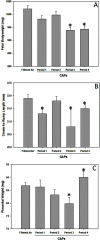Exposure to Ambient Particulate Matter during Specific Gestational Periods Produces Adverse Obstetric Consequences in Mice
- PMID: 28893721
- PMCID: PMC5744697
- DOI: 10.1289/EHP1029
Exposure to Ambient Particulate Matter during Specific Gestational Periods Produces Adverse Obstetric Consequences in Mice
Abstract
Background: Epidemiological studies associate inhalation of fine-sized particulate matter (PM2.5) during pregnancy with preterm birth (PTB) and low birth weight (LBW) but disagree over which time frames are most sensitive, or if effects are cumulative.
Objectives: Our objective was to provide experimental plausibility for epidemiological observations by testing the hypothesis that exposure to PM2.5 during discrete periods of pregnancy results in PTB and LBW.
Methods: For the first study, timed-pregnant B6C3F1 mice were exposed to concentrated ambient PM2.5 (CAPs) or filtered air (FA) throughout pregnancy [6 h/d from gestational day (GD) 0.5 through GD16.5]. A follow-up study examined the effects of CAPs exposure during discrete gestational periods (1: GD0.5–5.5; 2: GD6.5–14.5; 3: GD14.5–16.5; 4: GD0.5–16.5) aligning to milestones during human development.
Results: In the first experiment, exposure to 160 μg CAPs/m3 throughout pregnancy decreased gestational term by 0.5 d (∼1.1 wk decrease for humans) and birth weight by 11.4% compared with FA. The follow-up experiment investigated timing of CAPs exposure (mean concentrations at 178, 193, 171, and 173 μg/m3 for periods 1–4, respectively). Pregnancy was significantly shortened (vs. FA) by ∼0.4d when exposure occurred during gestational periods 2 and 4, and by ∼0.5d if exposure occurred during period 3. Exposure during periods 1, 2, and 4 reduced birth weight by ∼10% compared with FA, and placental weight was reduced (∼8%) on GD17.5 if exposure occurred only during period 3.
Conclusions: Adverse PM2.5-induced outcomes such as PTB and LBW are dependent upon the periods of maternal exposure. The results of these experimental studies could contribute significantly to air pollution policy decisions in the future. https://doi.org/10.1289/EHP1029.
Figures








Similar articles
-
Critical windows for maternal fine particulate matter exposure and adverse birth outcomes: The Shanghai birth cohort study.Chemosphere. 2020 Feb;240:124904. doi: 10.1016/j.chemosphere.2019.124904. Epub 2019 Sep 18. Chemosphere. 2020. PMID: 31550593
-
Maternal exposure to fine particulate matter and preterm birth and low birth weight in Africa.Environ Int. 2022 Feb;160:107053. doi: 10.1016/j.envint.2021.107053. Epub 2021 Dec 20. Environ Int. 2022. PMID: 34942408
-
Association of exposure to fine particulate matter wave over the preconception and pregnancy periods with adverse birth outcomes: Results from the project ELEFANT.Environ Res. 2022 Apr 1;205:112473. doi: 10.1016/j.envres.2021.112473. Epub 2021 Dec 2. Environ Res. 2022. PMID: 34863986
-
Maternal fine particulate matter (PM2.5) exposure and adverse birth outcomes: an updated systematic review based on cohort studies.Environ Sci Pollut Res Int. 2019 May;26(14):13963-13983. doi: 10.1007/s11356-019-04644-x. Epub 2019 Mar 20. Environ Sci Pollut Res Int. 2019. PMID: 30891704
-
Impact of ambient PM2.5 on adverse birth outcome and potential molecular mechanism.Ecotoxicol Environ Saf. 2019 Mar;169:248-254. doi: 10.1016/j.ecoenv.2018.10.109. Epub 2018 Nov 16. Ecotoxicol Environ Saf. 2019. PMID: 30453172 Review.
Cited by
-
Placental gene networks at the interface between maternal PM2.5 exposure early in gestation and reduced infant birthweight.Environ Res. 2021 Aug;199:111342. doi: 10.1016/j.envres.2021.111342. Epub 2021 May 18. Environ Res. 2021. PMID: 34015297 Free PMC article.
-
The Physiological Effects of Air Pollution: Particulate Matter, Physiology and Disease.Front Public Health. 2022 Jul 14;10:882569. doi: 10.3389/fpubh.2022.882569. eCollection 2022. Front Public Health. 2022. PMID: 35910891 Free PMC article. Review.
-
Adverse organogenesis and predisposed long-term metabolic syndrome from prenatal exposure to fine particulate matter.Proc Natl Acad Sci U S A. 2019 Jun 11;116(24):11590-11595. doi: 10.1073/pnas.1902925116. Epub 2019 May 28. Proc Natl Acad Sci U S A. 2019. PMID: 31138695 Free PMC article.
-
Inhale, exhale: Why particulate matter exposure in animal models are so acute? Data and facts behind the history.Data Brief. 2019 Jul 8;25:104237. doi: 10.1016/j.dib.2019.104237. eCollection 2019 Aug. Data Brief. 2019. PMID: 31367664 Free PMC article.
-
Exposure to fine and ultrafine particulate matter during gestation alters postnatal oligodendrocyte maturation, proliferation capacity, and myelination.Neurotoxicology. 2018 Mar;65:196-206. doi: 10.1016/j.neuro.2017.10.004. Epub 2017 Oct 24. Neurotoxicology. 2018. PMID: 29079486 Free PMC article.
References
Publication types
MeSH terms
Substances
Grants and funding
LinkOut - more resources
Full Text Sources
Other Literature Sources
Medical
Miscellaneous

